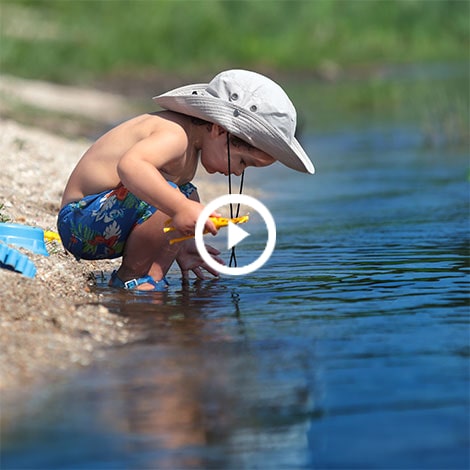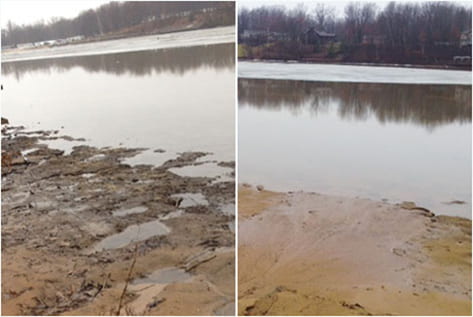There are few things nastier than stepping into a cool, refreshing lake on a hot summer day only to feel that slimy goo squish between your toes. Fortunately, you can follow a few simple steps for pond and lake muck removal.
Pond muck, also known as pond sludge, is made up of fish waste, decaying plants, and other organic materials that accumulate at the bottom of your pond. Over time, pond muck can accumulate to be several inches thick and can become a great home for leeches. You can learn more about muck in our article, What is Muck?, but the good news is that muck and sludge accumulation is reversible. Pond and lake muck removal is possible with a one-two punch of beneficial bacteria and aeration.
Beneficial Bacteria
Billions of beneficial bacteria already live in your pond and work hard to break down pond sludge, but if you have large amounts of it, they are probably overworked and outnumbered. You can boost their numbers with regular doses of MuckAway, a popular pond muck cleaner. The special blend of aerobic beneficial bacteria sinks to the bottom where it will digest organic debris (a.k.a. muck), improve water clarity, and eliminate noxious odors. One of the best pond muck removers, MuckAway works well even in areas that experience high water flow, like canals, beaches, and lakefront property.
When applied consistently once every two weeks when water temperatures are above 50ºF and used with a bottom-diffused aeration system, MuckAway can eliminate 1-2 inches of muck per month.
Here's what we recommend in order to get the best results:
- Disburse Evenly: When using MuckAway, normally for spot treatments around the shoreline or beach area, the pellets will need to be spread evenly across the treatment area. Plan to use one scoop per 1,000 square feet. When using MuckAway Total Lake for treatment areas less than two surface acres, evenly broadcast 12 lbs. per acre by boat or raft every two weeks. For treatment areas larger than two surface acres, apply treatments every four weeks.
- Use a Boat: If you are treating the entire pond or lake, consider using a boat for uniform MuckAway dispersal. Individual tablets that are spread very far apart (tossed from the shore) will not have as dramatic an impact on pond sludge as those that are densely and evenly distributed.
- Combine Forces: Many customers choose to use a one-two punch when contending with water clarity issues. Try using PondClear Beneficial Bacteria along with MuckAway or MuckAway Total Lake to clean and clear the water column while breaking down the sunken pond muck.
Aeration
A good pond aerator is also key to pond muck removal. Oxygen is not only good for fish and aquatic life, but it also supports the growth of beneficial bacteria in the pond.
Aeration also prevents thermocline, which is when the water column stagnates and forms layers. The upper portion of the body of water that's exposed to air contains oxygen while the deeper areas lack oxygen – which is where your beneficial bacteria live (or are struggling to survive!). Implementing an Airmax Aeration System will circulate the contents of your pond and infuse the entire water column with oxygen. This influx in oxygen helps beneficial bacteria flourish and feed on all that accumulated organic debris.
Manual Pond and Lake Muck Removal
Although not the easiest or most fun job, you can remove some of the pond sludge with a Razer Rake and a bucket or wheelbarrow. You can increase the effectiveness of MuckAway and MuckAway Total Lake by raking out any large debris from the pond before you begin treatments. This allows those aerobic beneficial bacteria to target the fine debris that's difficult to remove.
Wrapping Up
Nobody likes pond muck, but following these pond and lake muck removal tips will put you well on your way to a clear and clean shoreline in no time. If you have any additional questions about pond sludge or the best pond muck removers and cleaners, don't hesitate to contact our team of experts for assistance.
Last Updated: February 1, 2023

